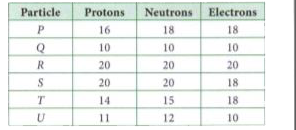Complete Solutions to SECTION-C of chapter FOOTSTEPS TOWARDS(CBSE BOARD) of Class 9 book with complete answers and questions
| Class 9 | CHEMISTRY |
| Chapter | FOOTSTEPS TOWARDS(CBSE BOARD) |
| MTG IIT JEE FOUNDATION | SECTION-C |
| Number Of Questions | 15 |
| Academic Year | 2023-24 |
A hot solution contains 5g of a substance in 15g of water at `35^(@)C`. What is the solubility of the substance at this temperature?
View SolutionA beam of light is visible when it is passed through a colloidal solution, but it is not visible when passed through true solution and suspensions. Explain.
View SolutionSmoke and fog both are aerosols. In what way are they different?
View SolutionHow do sol and gel differ from each other? Give one example for each.
View SolutionClassify the following as sol, solution and suspension `:`
(i) Milk of magnesia (ii) Coloured gemstones
(iii) Aerated drinks (iv) Sand in water
View SolutionWhat is the number of valence electrons in the atom of an element A having atomic number 20? Name the valence shell of this atom.
View SolutionThe atomic number and the mass number of an element M are 12 and 24 respectively . Calculate the number of neutrons in an atom of the element.
View SolutionCalculate the mass of
(i) one atom of aluminium
(ii) 3.0 mol of `Cl^(-)` ion
(iii) 10 carbon atoms
( At. Mass `:` O = 16u, Cl = 35.5u, Na = 23u, Al= 27u, C = 12u )
View SolutionThe diagram shows the apparatus set-up for an experiment. Gas jar ( A) contains a brown gas, nitrogren dioxide and gas jar ( B) contains hydrogen > The molecular masses of nitrogen dioxide and hydrogen are 46 and 2 respectively.

Describe and explain the follwoing observations in the two gas jars as the experiment proceeds.
The colour of the gas.
View SolutionThe diagram shows the apparatus set-up for an experiment. Gas jar ( A) contains a brown gas, nitrogren dioxide and gas jar ( B) contains hydrogen > The molecular masses of nitrogen dioxide and hydrogen are 46 and 2 respectively.

Describe and explain the follwoing observations in the two gas jars as the experiment proceeds.
The speed of the gas particles.
View SolutionThe diagram shows the apparatus set-up for an experiment. Gas jar ( A) contains a brown gas, nitrogren dioxide and gas jar ( B) contains hydrogen > The molecular masses of nitrogen dioxide and hydrogen are 46 and 2 respectively.

Describe and explain the follwoing observations in the two gas jars as the experiment proceeds.
The amount of the gases in the gas jars.
View SolutionA metal M forms an ionic compound X of formula `M_(2)(SO_(4))_(3)`.
(a) Identify the cation in X.
(b) Given the relative formula mass of X is 392, determine the relative atomic mass of metal M.
(c) (i) What is the formula of the nitrate of metal M?
(ii) Calculate the relative formula mass of nitrate compound in (c)(i).
View SolutionTell whether each of the following properties describes a heterogeneous mixture, a solution or a homogeneous mixture, a compound or an element.
(i) A homogeneous liquid which leaves a solid residue on boiling.
(ii) A cloudly liquid which after some time appear more cloudly towards the bottom.
(iii) A uniform white solid that has a sharp and definite melting point which cannot be decomposed into simpler substances by special techniques.
(iv) A colourless liquid which boils at definite temperature and can be decomposed into simpler substances.
View SolutionTake three test tubes and label them as A,B and C. Fill upto two -third with sugar solution, chalk powder in water and milk, respectively. Allow these to stand on test tube stand for some time.
(i) In which of the test tubes will you observe particles settle down?
(ii) Which of the test tubes will look transparent?
(iii) Which of the test tubes will look opaque ?
View SolutionThe given table shows the sub-atomic particles of six particles, represented by the letters P to U .
( The letters are not the actual symbols of the particles . )

(a) Find the particles which can be
(i) noble gases.
(ii) positive ions.
(iii) negative ions.
(b) Which two particles are an atom and an ion of the same element?
(c ) (i) Which particle is the lightest ?
(ii) Which particle is the heaviest?
View Solution
SECTION-C questions and complete solutions for chapter FOOTSTEPS TOWARDS(CBSE BOARD) of MTG IIT JEE FOUNDATION of Class 9